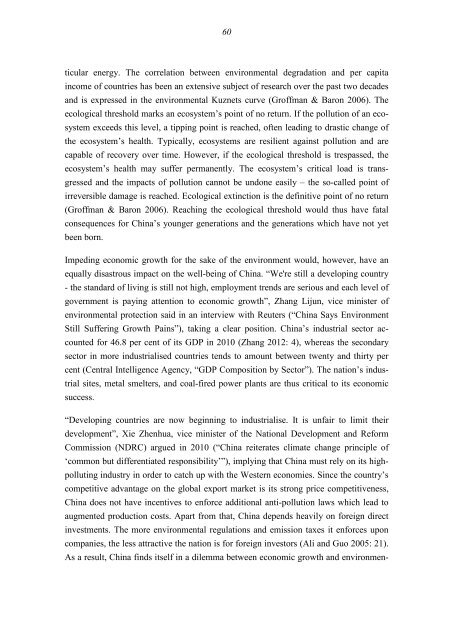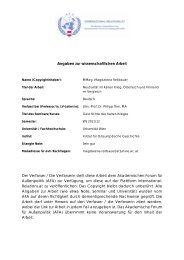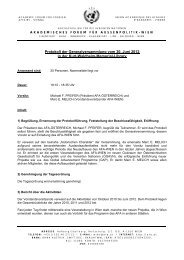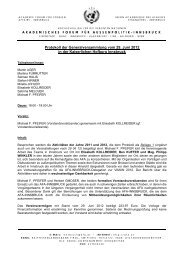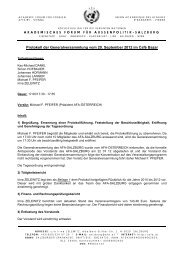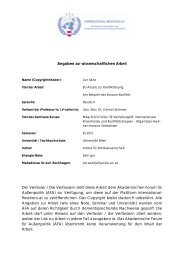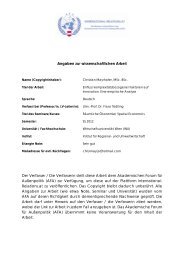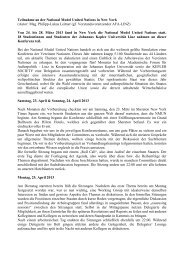GAP-JOURNAL 2012/13 - AFA
GAP-JOURNAL 2012/13 - AFA
GAP-JOURNAL 2012/13 - AFA
Erfolgreiche ePaper selbst erstellen
Machen Sie aus Ihren PDF Publikationen ein blätterbares Flipbook mit unserer einzigartigen Google optimierten e-Paper Software.
60<br />
ticular energy. The correlation between environmental degradation and per capita<br />
income of countries has been an extensive subject of research over the past two decades<br />
and isexpressed inthe environmental Kuznets curve (Groffman &Baron 2006). The<br />
ecological threshold marks anecosystem’s point of no return. If the pollution ofanecosystem<br />
exceeds this level, atipping point is reached, often leading todrastic change of<br />
the ecosystem’s health. Typically, ecosystems are resilient against pollution and are<br />
capable of recovery over time. However, if the ecological threshold istrespassed, the<br />
ecosystem’s health may suffer permanently. The ecosystem’s critical load is transgressed<br />
and the impacts ofpollution cannot be undone easily –the so-called point of<br />
irreversible damage is reached. Ecological extinction isthe definitive point of no return<br />
(Groffman &Baron 2006). Reaching the ecological threshold would thus have fatal<br />
consequences for China’s younger generations and the generations which have not yet<br />
been born.<br />
Impeding economic growth for the sake of the environment would, however, have an<br />
equally disastrous impact onthe well-being ofChina. “We're still adeveloping country<br />
-the standard of living isstill not high, employment trends are serious and each level of<br />
government is paying attention toeconomic growth”, Zhang Lijun, vice minister of<br />
environmental protection said inaninterview with Reuters (“China Says Environment<br />
Still Suffering Growth Pains”), taking aclear position. China’s industrial sector accounted<br />
for 46.8 per cent ofits GDP in 2010 (Zhang <strong>2012</strong>: 4), whereas the secondary<br />
sector in more industrialised countries tends to amount between twenty and thirty per<br />
cent (Central Intelligence Agency, “GDP Composition bySector”). The nation’s industrial<br />
sites, metal smelters, and coal-fired power plants are thus critical to its economic<br />
success.<br />
“Developing countries are now beginning to industrialise. It is unfair tolimit their<br />
development”, Xie Zhenhua, vice minister ofthe National Development and Reform<br />
Commission (NDRC) argued in 2010 (“China reiterates climate change principle of<br />
‘common but differentiated responsibility’”), implying that China must rely onits highpolluting<br />
industry in order tocatch up with the Western economies. Since the country’s<br />
competitive advantage onthe global export market is its strong price competitiveness,<br />
China does not have incentives to enforce additional anti-pollution laws which lead to<br />
augmented production costs. Apart from that, China depends heavily onforeign direct<br />
investments. The more environmental regulations and emission taxes itenforces upon<br />
companies, the less attractive the nation isfor foreign investors (Ali and Guo 2005: 21).<br />
As aresult, China finds itself in adilemma between economic growth and environmen-


